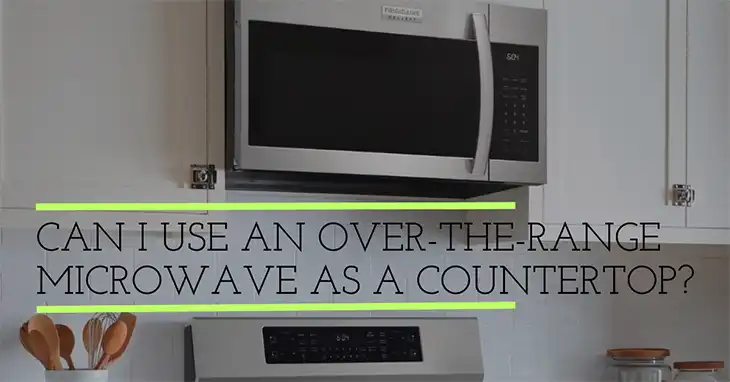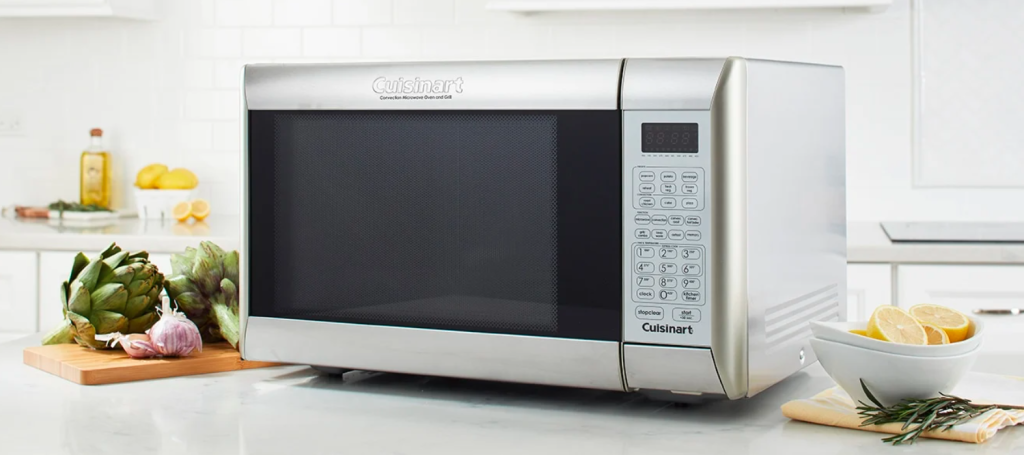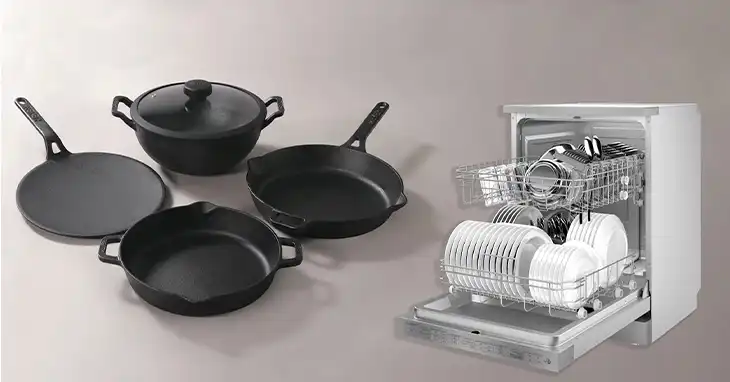Can I Use an Over-the-Range Microwave as a Countertop?
In today’s bustling world, efficiency and functionality are key in any kitchen setup. With limited counter space, it’s tempting to consider using an over-the-range microwave as a countertop appliance. However, before making this decision, it’s crucial to understand the potential risks and explore suitable alternatives.
First thing first, yes, you can use over-the-range microwaves as countertops. However, it’s not safe to do so, which we’ll discuss below and follow it up with some alternatives that you can consider. Let’s begin.

Why Over-the-Range Microwaves Aren’t Designed for Countertops
Over-the-range microwaves are specifically engineered to be mounted above a range or cooktop, not on a countertop. Using them as countertop appliances can pose significant safety hazards.
Let’s take a look at what safety risks it poses.
Overheating Risks
One of the primary concerns is the potential for overheating. Over-the-range microwaves are designed with built-in ventilation systems to expel heat efficiently. When placed on a countertop, this ventilation can be obstructed, leading to excessive heat buildup and increasing the risk of fire or damage to surrounding surfaces.
As highlighted in a Reddit thread, a user shared their experience: “I had an over-the-range microwave installed on the counter, and after a few months, the cabinets above started to discolor and warp due to the heat buildup.”
Stability and Tipping Hazards
Over-the-range microwaves are not designed with a stable, flat base suitable for countertop use. Their mounting brackets and irregular shapes can make them prone to tipping or falling, especially when loaded with heavy dishes or subjected to accidental bumps or knocks.
Improper Ventilation
Proper ventilation is crucial for removing steam, odors, and smoke generated during cooking. Over-the-range microwaves rely on their integrated venting system to expel these byproducts effectively. When used on a countertop, this ventilation path is disrupted, leading to potential smoke buildup and lingering odors in your kitchen.
Safety Certifications
It’s important to note that over-the-range microwaves are certified by organizations like Underwriters Laboratories (UL) for specific installations, typically mounted above a range or cooktop. Using them in an unapproved manner may void the manufacturer’s warranty and compromise safety standards.
Alternative Countertop Microwave Solutions

Instead of repurposing an over-the-range microwave, it’s recommended to explore purpose-built countertop microwave options. These appliances are designed specifically for countertop use and offer a range of sizes, features, and styles to suit your needs.
Countertop Microwave Options
Countertop microwaves come in various sizes, from compact models for small spaces to larger units with ample interior capacity. Popular features include:
- Multiple power levels for precise cooking
- Sensor cooking for automatic adjustments
- Defrost settings for thawing frozen foods
- Sleek finishes like stainless steel or black to complement your kitchen’s aesthetic
When selecting a countertop microwave, consider factors such as your available counter space, desired capacity, and specific cooking needs. Refer to reputable buying guides and expert reviews to help you make an informed choice.
Countertop Convection Microwave Ovens
For those seeking advanced cooking capabilities, countertop convection microwave ovens combine the speed of microwaving with the browning and crisping abilities of a conventional oven. These versatile appliances use a built-in fan to circulate hot air, resulting in more even cooking and better browning.
While countertop convection microwaves are generally more expensive than standard models, they offer greater versatility and can often replace a traditional oven for various cooking tasks.
Can You Convert an Over-the-Range Microwave to a Countertop?
While it may seem tempting to modify an over-the-range microwave for countertop use, it is strongly advised against due to the inherent safety risks involved. Attempting such modifications can compromise the appliance’s integrity and potentially create hazardous situations.
Risks of DIY Modifications
Altering an over-the-range microwave’s ventilation system to work on a countertop is a complex task that requires extensive knowledge and expertise. Improper modifications can lead to issues such as:
- Inadequate heat dissipation, increasing the risk of overheating and fire
- Disrupted airflow, resulting in poor ventilation and smoke buildup
- Aesthetic challenges, such as exposed wiring or an unfinished back panel
As stated by a home appliance expert on a popular forum, “Attempting to convert an over-the-range microwave for countertop use is extremely risky and should be avoided. These appliances are engineered for specific installations, and modifying them can have serious safety consequences.”
Professional Countertop Microwave Installation
If you’re set on having a countertop microwave, it’s advisable to hire a qualified appliance technician or contractor to handle the installation properly. Professional installation ensures that the microwave is correctly positioned, vented, and safely connected to the required electrical outlets.
When choosing a professional, consider factors such as their experience, licensing, insurance coverage, and customer reviews. A reputable installer will follow all necessary safety codes and regulations, ensuring a safe and functional setup for your new countertop microwave.
Countertop vs. Over-the-Range Microwaves: Pros and Cons
While countertop microwaves offer a convenient and space-saving solution, over-the-range microwaves have their own set of advantages and disadvantages. To help you make an informed decision, let’s explore the pros and cons of each type:
| Countertop Microwaves | Over-the-Range Microwaves |
| Pros: | Pros: |
| – Freestanding and movable | – Saves counter space |
| – Generally more affordable | – Often comes with a vent to remove odors and steam |
| – No installation required (ideal for renters) | – Can enhance the look of your kitchen range |
| Cons: | Cons: |
| – Takes up counter space | – Requires professional installation (additional cost) |
| – Lacks a vent for odor/steam removal | – May not be suitable for all kitchens (limited space, height restrictions) |
| – Generally more expensive than countertop models |
Ultimately, the choice between a countertop or over-the-range microwave depends on your individual needs, kitchen layout, and personal preferences. Consider factors such as available counter space, ventilation requirements, budget, and aesthetic preferences when making your decision.
FAQs
Can I use an over-the-range microwave on a countertop without any modifications?
No, it’s not recommended to use an over-the-range microwave on a countertop without modifications. These microwaves are designed to be mounted above a range or cooktop and require proper ventilation and airflow. Placing them on a countertop can lead to overheating, stability issues, and potential fire hazards.
Are there any exceptions where an over-the-range microwave can be used on a countertop?
In rare cases, some over-the-range microwave models may be designed or approved for countertop use by the manufacturer. However, this is uncommon, and it’s essential to consult the manufacturer’s instructions and specifications before attempting to use an over-the-range microwave on a countertop.
Can I hire a professional to modify an over-the-range microwave for countertop use?
While it’s possible to hire a professional to modify an over-the-range microwave for countertop use, it’s generally not recommended due to the potential safety risks and challenges involved. Most experts advise against such modifications and recommend purchasing a purpose-built countertop microwave instead.
How do I properly maintain and clean my countertop microwave?
Regular cleaning and maintenance are essential for ensuring your countertop microwave operates efficiently and safely. Follow these tips:
- Consult your microwave’s manual for recommended cleaning procedures and approved cleaning products.
- Wipe down the interior and exterior surfaces with a damp cloth or mild cleaning solution after each use to prevent buildup of food and grease.
- Clean the turntable and interior walls periodically to remove any spills or splatters.
- Keep the vents and filters clean to allow proper airflow and prevent overheating.
- Periodically check for any loose components or wear and tear, and seek professional repair if necessary.
Can I install a microwave trim kit to give my countertop microwave a built-in look?
Yes, microwave trim kits are available to help integrate your countertop microwave into your cabinetry for a seamless, built-in appearance. These kits typically include a frame or trim piece that surrounds the microwave, providing a finished look. However, it’s essential to follow the manufacturer’s instructions carefully and ensure proper ventilation and clearance around the microwave.
End Notes
Deciding whether to use an over-the-range microwave as a countertop appliance is a decision that should not be taken lightly. While it may seem like a convenient solution, the potential safety risks and drawbacks often outweigh the benefits. By understanding the underlying issues and exploring suitable alternatives, you can make an informed choice that prioritizes safety, functionality, and the overall aesthetic of your kitchen.
Countertop microwaves offer a purpose-built solution that can seamlessly integrate into your kitchen design while providing the convenience and versatility you need. With a wide range of sizes, features, and styles available, you’re sure to find a countertop microwave that meets your unique requirements.




![How Do You Measure a Frying Pan? [Answered]](https://kitchenstow.com/wp-content/uploads/2024/08/How-Do-You-Measure-a-Frying-Pan-.webp)

